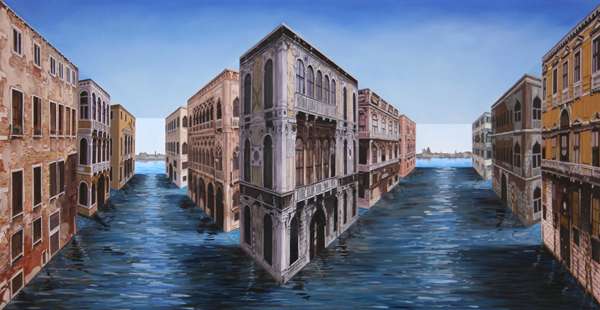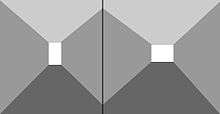Patrick Hughes (artist)
Patrick Hughes (born 20 October 1939)[1] is a British artist working in London. He is the creator of "reverspective", an optical illusion on a three-dimensional surface where the parts of the picture which seem farthest away are actually physically the nearest.
Patrick Hughes | |
|---|---|
| Born | October 20, 1939 Birmingham |
| Nationality | British |
| Education | James Graham Day College |
| Known for | Artist |
Notable work | Paradoxymoron: Foolish Wisdom in Words and Pictures |
| Style | "Reverspective" |
| Home town | London |
| Spouse(s) | Rennie Paterson |
| Website | Official web site |

Life
Patrick Hughes was born in Birmingham, attended school in Hull and went on at the James Graham Day College in Leeds in 1959. Later he taught at the Leeds College of Art before becoming an independent artist. He has three sons by his first wife, Rennie Paterson, and was later married to the author Molly Parkin. Hughes lives above his studio near Old Street, London, with his third wife, the historian and biographer Diane Atkinson.[2]
Art
In July 2011, Hughes celebrated 'Fifty Years in Showbusiness' with two exhibitions, a retrospective at Flowers East, and current works in Flowers Cork Street.[3]
Hughes' early works were often playful, putting things back to front or squashing them flat, like Clown (1963) and Liquorice Allsorts (1960), setting words against images, like One Two (1962), or against themselves, like Tick Cross (1962). He explored visual oxymorons and paradoxes.[2] His fascination with the illusion of perspective began with works like Infinity (1963), Three Doors (1964) and The Space Ruler (1965).
In the 1970s Hughes hung his investigations of perception and illusion on the motif of the rainbow in a series of prints and paintings, such as Pile of Rainbows (1973), Prison Rainbow (1973) and Leaning on a Landscape (1979). Later prints like Leaf Art (1975) and paintings like Realistic Paint (1977) expressed similar interests with colour.[4]
His first "reverse perspective" or "reverspective" was Sticking Out Room (1964), which was a life-size room for the Institute of Contemporary Arts (ICA) in 1970. He returned to explore the possibilities of reverspective in 1990 with Up the Line and Down the Road (1991)[2] Since then, his reverspectives have been shown in London, New York, Santa Monica, Seoul, Chicago, Munich and Toronto.
His work entitled Paradoxymoron is currently exhibited in the British Library, London. It shows a set of library book stacks, which appear to move in an extremely disconcerting way as the viewer's eyes move.
He explains reverspective:
Reverspectives are three-dimensional paintings that when viewed from the front initially give the impression of viewing a painted flat surface that shows a perspective view. However as soon as the viewer moves their head even slightly the three dimensional surface that supports the perspective view accentuates the depth of the image and accelerates the shifting perspective far more than the brain normally allows. This provides a powerful and often disorienting impression of depth and movement. The illusion is made possible by painting the view in reverse to the relief of the surface, that is, the bits that stick farthest out from the painting are painted with the most distant part of the scene.[5]


The picture surface of Vanishing Venice (above) is three-dimensional, made of two pyramids with their tops cut off protruding towards the viewer: the bases of the pyramids are farthest away (flat against the wall), while the flat tops (shown as the two lighter rectangles in the diagram, right) are those parts which are physically nearest to the viewer but which appear, in the picture, to be in the distance at the end of the buildings.
Hughes' reverspective is the subject of scientific papers on the psychology of perception, by Nicholas Wade[6] and Thomas Papathomas of Rutgers University's Laboratory of Vision Research.[7][8][9]
Writing
Hughes has written four books investigating themes that parallel his art. His latest is Paradoxymoron: Foolish Wisdom in Words and Pictures,[10] published in 2011. His other books are Vicious Circles and Infinity: A Panoply of Paradoxes[11] (with artist George Brecht); Upon the Pun: Dual Meaning in Words and Pictures, with Paul Hammond (London, W.H. Allen, 1978); and More on Oxymoron (Jonathan Cape, Ltd. 1984) which investigates both verbal and visual oxymoron. He has written for The Observer, The Guardian and ICA Magazine, among others, on art, artists and interesting lives. A collection of his writings, Left to Write, was published by Momentum in 2008. The third edition of John Slyce's Patrick Hughes: Perverspective was published in 2011, with a new afterword by Murray McDonald.[12] Most recently, A New Perspective, a 240-page monograph with essays by Professor Dawn Adès, Professor Martin Kemp, Murray McDonald and Dr Thomas Papathomas, was published by Flowers Gallery in November 2014, followed by A Newer Perspective, in 2017.
Influences
Hughes has been influenced by the surrealistic Lilliput, comics and the absurdist theatre of Ionesco and N. F. Simpson, as well as the work of Paul Klee and Surrealists, particularly René Magritte, Giorgio de Chirico and Marcel Marien. The Leeds-based surrealist Anthony Earnshaw was a friend and inspiration.
Bibliography
Exhibition catalogues
- Patrick Hughes: Deeperspective [catalogue of the exhibition held at Flowers East 22 October – 21 November 1999] London.
- Patrick Hughes: Multiples [catalogue of the exhibition Multispectives held at Flowers East 26 October – 24 November 2012] London.
- Patrick Hughes: Properspective [catalogue of the exhibition held at Flowers East 10 February – 10 March 2001] London.
- Patrick Hughes: Retrospectives [catalogue of the exhibition held at Flowers East 19 October – 17 November 1994] London.
- Patrick Hughes: Superduperspective [catalogue of the exhibition held at Flowers East 2006] London.
- Patrick Hughes: The Prints in Between 1983 – 1995 [catalogue of the exhibition held at Flowers East 19 October – 17 November 2007] London.
- Whopperspective [catalogue of the exhibition held at Flowers East 2003] London.
Monographs
- Ades, D., Kemp, M, Papathomas, T. et al. (2014) A New Perspective. Reverspective Ltd, London
- Hughes, P. (2011) Paradoxymoron: Foolish Wisdom in Words and Pictures. Reverspective Ltd, London.
- Slyce, J. (2011) Patrick Hughes: Perverspective. Momentum, London.
See also
- Ripple pictures
References
- "Birthdays". The Guardian. Guardian News & Media. 20 October 2014. p. 35.
- John Slyce, Reverspective Momentum, London, 2005
- "Jessamy Calkin, 'The World of Patrick Hughes, Artist'". Daily Telegraph. 12 July 2011. Retrieved 22 July 2011.
- B. Smith, P. Hughes, Behind the Rainbow: Patrick Hughes, Prints 1964–83 Paradox Publishing Ltd, 1983
- patrickhughes.co.uk Archived 4 July 2007 at the Wayback Machine
- Wade, Nicholas. "Fooling the eyes: trompe l'oeil and reverse perspective", Perception, 1999, Volume 28, pp. 1115–1119.
- Papathomas, Thomas V. "Experiments on the role of painted cues in Hughes’s reverspectives", Perception, Volume 31, pp. 521–530, 2002.
- Papathomas Thomas V & Bono Lisa. "Experiments with a hollow mask and a reverspective: Top-down influences in the inversion effect for 3-D stimuli," Perception, 33, 1129–1138, 2004.
- Papathomas Thomas V. "Art pieces that ‘move’ in our minds – An explanation of illusory motion based on depth reversal," Spatial Vision, 21, 79–95, 2007.
- ISBN 0956806104
- Hughes, Patrick; Brecht, George (1975). Vicious Circles and Infinity – A Panoply of Paradoxes. Garden City, New York: Doubleday. ISBN 0-385-09917-7. LCCN 74-17611.
- Archived 24 December 2010 at the Wayback Machine
External links
| Wikimedia Commons has media related to Patrick Hughes (artist). |